Genapsys Case Study: Market Analysis, Strategies, and Risks
VerifiedAdded on 2022/01/18
|7
|2126
|374
Case Study
AI Summary
This case study analyzes the Genapsys business, focusing on three potential market strategies: a traditional sales model, a razor and razor blade model, and a data analytics approach. The analysis examines the market conditions, competitive landscape, and required operating performance for each strategy's success. It delves into the major risks associated with each model, including financial and strategic tensions, and identifies the critical factors that must align for each strategy to succeed. The study also explores the potential consequences of failure for each approach and concludes by evaluating which strategy would best maximize the value realized by the founders, considering both short-term and long-term implications, including financial returns, product lifecycle, and competitive advantages. The document provides a comprehensive overview of the Genapsys case, offering insights into strategic decision-making and risk management in a competitive market.
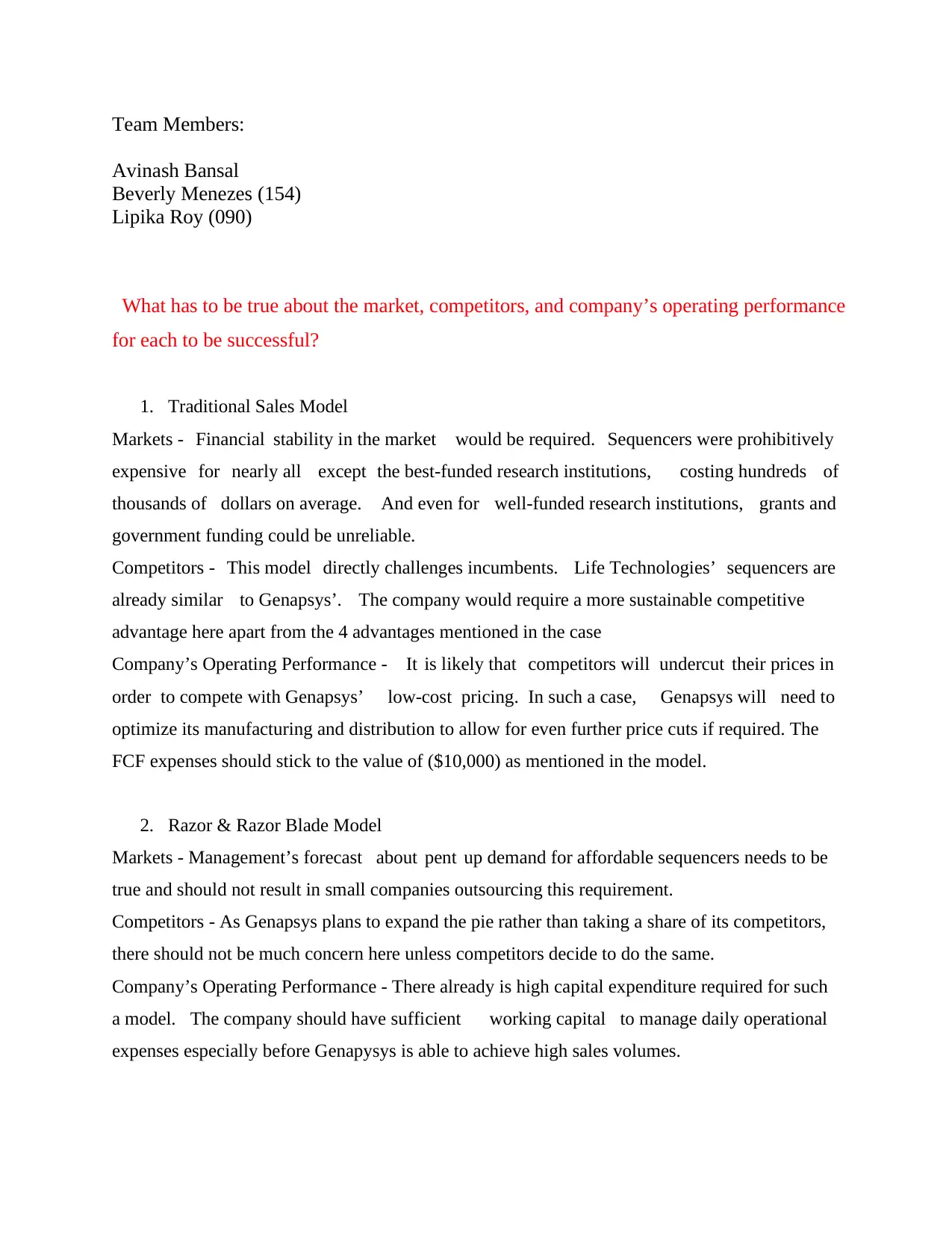
Team Members:
Avinash Bansal
Beverly Menezes (154)
Lipika Roy (090)
What has to be true about the market, competitors, and company’s operating performance
for each to be successful?
1. Traditional Sales Model
Markets - Financial stability in the market would be required. Sequencers were prohibitively
expensive for nearly all except the best-funded research institutions, costing hundreds of
thousands of dollars on average. And even for well-funded research institutions, grants and
government funding could be unreliable.
Competitors - This model directly challenges incumbents. Life Technologies’ sequencers are
already similar to Genapsys’. The company would require a more sustainable competitive
advantage here apart from the 4 advantages mentioned in the case
Company’s Operating Performance - It is likely that competitors will undercut their prices in
order to compete with Genapsys’ low-cost pricing. In such a case, Genapsys will need to
optimize its manufacturing and distribution to allow for even further price cuts if required. The
FCF expenses should stick to the value of ($10,000) as mentioned in the model.
2. Razor & Razor Blade Model
Markets - Management’s forecast about pent up demand for affordable sequencers needs to be
true and should not result in small companies outsourcing this requirement.
Competitors - As Genapsys plans to expand the pie rather than taking a share of its competitors,
there should not be much concern here unless competitors decide to do the same.
Company’s Operating Performance - There already is high capital expenditure required for such
a model. The company should have sufficient working capital to manage daily operational
expenses especially before Genapysys is able to achieve high sales volumes.
Avinash Bansal
Beverly Menezes (154)
Lipika Roy (090)
What has to be true about the market, competitors, and company’s operating performance
for each to be successful?
1. Traditional Sales Model
Markets - Financial stability in the market would be required. Sequencers were prohibitively
expensive for nearly all except the best-funded research institutions, costing hundreds of
thousands of dollars on average. And even for well-funded research institutions, grants and
government funding could be unreliable.
Competitors - This model directly challenges incumbents. Life Technologies’ sequencers are
already similar to Genapsys’. The company would require a more sustainable competitive
advantage here apart from the 4 advantages mentioned in the case
Company’s Operating Performance - It is likely that competitors will undercut their prices in
order to compete with Genapsys’ low-cost pricing. In such a case, Genapsys will need to
optimize its manufacturing and distribution to allow for even further price cuts if required. The
FCF expenses should stick to the value of ($10,000) as mentioned in the model.
2. Razor & Razor Blade Model
Markets - Management’s forecast about pent up demand for affordable sequencers needs to be
true and should not result in small companies outsourcing this requirement.
Competitors - As Genapsys plans to expand the pie rather than taking a share of its competitors,
there should not be much concern here unless competitors decide to do the same.
Company’s Operating Performance - There already is high capital expenditure required for such
a model. The company should have sufficient working capital to manage daily operational
expenses especially before Genapysys is able to achieve high sales volumes.
Paraphrase This Document
Need a fresh take? Get an instant paraphrase of this document with our AI Paraphraser
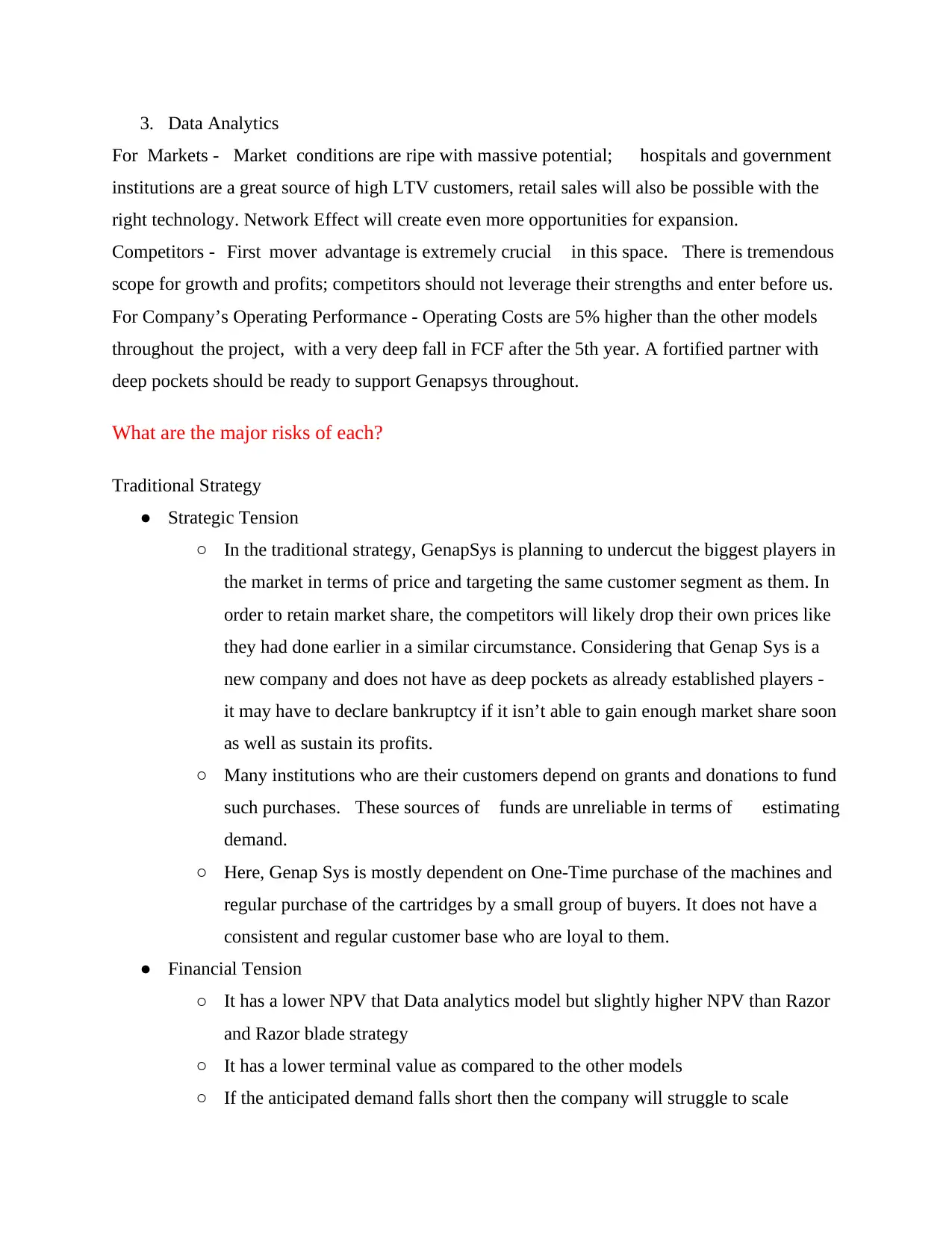
3. Data Analytics
For Markets - Market conditions are ripe with massive potential; hospitals and government
institutions are a great source of high LTV customers, retail sales will also be possible with the
right technology. Network Effect will create even more opportunities for expansion.
Competitors - First mover advantage is extremely crucial in this space. There is tremendous
scope for growth and profits; competitors should not leverage their strengths and enter before us.
For Company’s Operating Performance - Operating Costs are 5% higher than the other models
throughout the project, with a very deep fall in FCF after the 5th year. A fortified partner with
deep pockets should be ready to support Genapsys throughout.
What are the major risks of each?
Traditional Strategy
● Strategic Tension
○ In the traditional strategy, GenapSys is planning to undercut the biggest players in
the market in terms of price and targeting the same customer segment as them. In
order to retain market share, the competitors will likely drop their own prices like
they had done earlier in a similar circumstance. Considering that Genap Sys is a
new company and does not have as deep pockets as already established players -
it may have to declare bankruptcy if it isn’t able to gain enough market share soon
as well as sustain its profits.
○ Many institutions who are their customers depend on grants and donations to fund
such purchases. These sources of funds are unreliable in terms of estimating
demand.
○ Here, Genap Sys is mostly dependent on One-Time purchase of the machines and
regular purchase of the cartridges by a small group of buyers. It does not have a
consistent and regular customer base who are loyal to them.
● Financial Tension
○ It has a lower NPV that Data analytics model but slightly higher NPV than Razor
and Razor blade strategy
○ It has a lower terminal value as compared to the other models
○ If the anticipated demand falls short then the company will struggle to scale
For Markets - Market conditions are ripe with massive potential; hospitals and government
institutions are a great source of high LTV customers, retail sales will also be possible with the
right technology. Network Effect will create even more opportunities for expansion.
Competitors - First mover advantage is extremely crucial in this space. There is tremendous
scope for growth and profits; competitors should not leverage their strengths and enter before us.
For Company’s Operating Performance - Operating Costs are 5% higher than the other models
throughout the project, with a very deep fall in FCF after the 5th year. A fortified partner with
deep pockets should be ready to support Genapsys throughout.
What are the major risks of each?
Traditional Strategy
● Strategic Tension
○ In the traditional strategy, GenapSys is planning to undercut the biggest players in
the market in terms of price and targeting the same customer segment as them. In
order to retain market share, the competitors will likely drop their own prices like
they had done earlier in a similar circumstance. Considering that Genap Sys is a
new company and does not have as deep pockets as already established players -
it may have to declare bankruptcy if it isn’t able to gain enough market share soon
as well as sustain its profits.
○ Many institutions who are their customers depend on grants and donations to fund
such purchases. These sources of funds are unreliable in terms of estimating
demand.
○ Here, Genap Sys is mostly dependent on One-Time purchase of the machines and
regular purchase of the cartridges by a small group of buyers. It does not have a
consistent and regular customer base who are loyal to them.
● Financial Tension
○ It has a lower NPV that Data analytics model but slightly higher NPV than Razor
and Razor blade strategy
○ It has a lower terminal value as compared to the other models
○ If the anticipated demand falls short then the company will struggle to scale
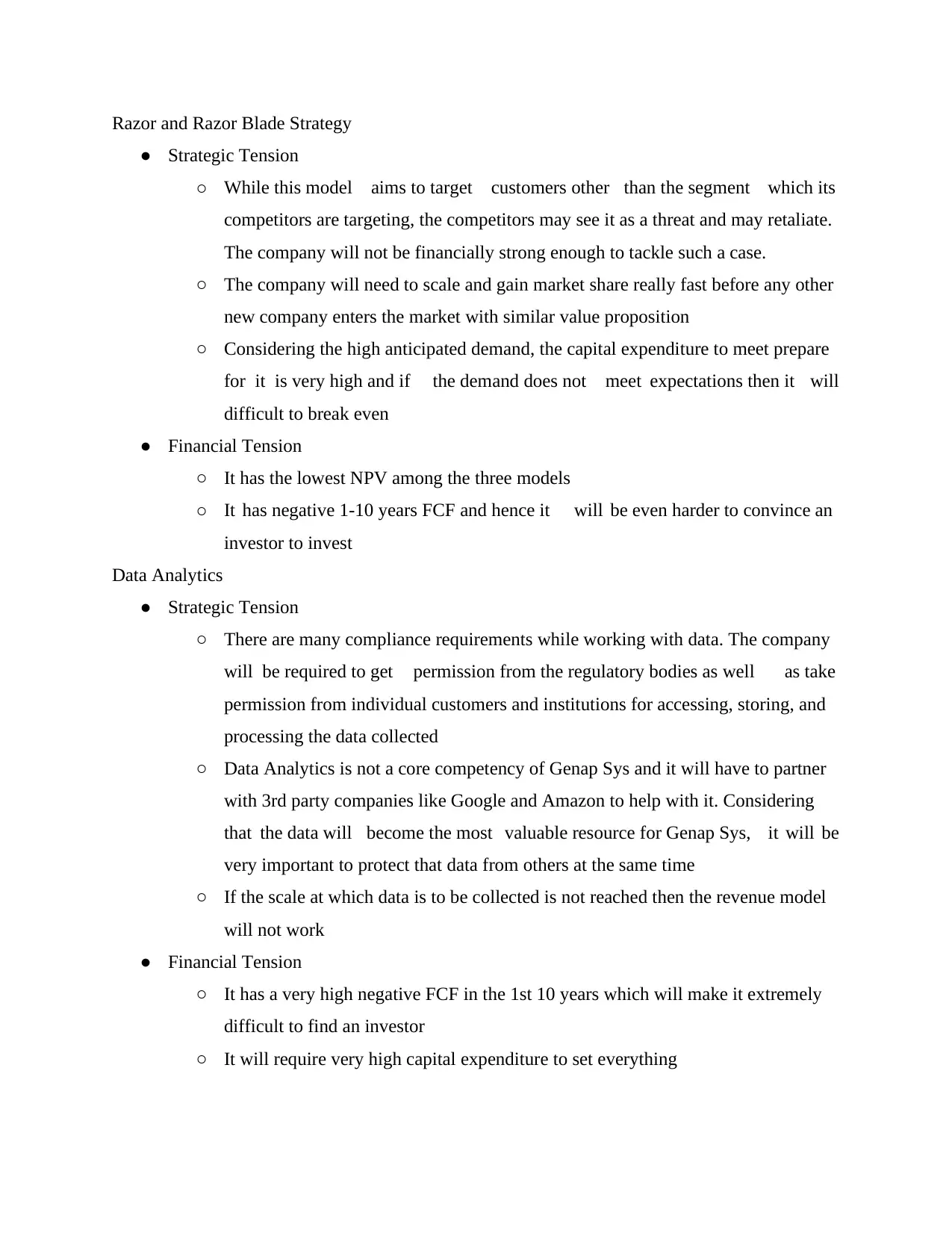
Razor and Razor Blade Strategy
● Strategic Tension
○ While this model aims to target customers other than the segment which its
competitors are targeting, the competitors may see it as a threat and may retaliate.
The company will not be financially strong enough to tackle such a case.
○ The company will need to scale and gain market share really fast before any other
new company enters the market with similar value proposition
○ Considering the high anticipated demand, the capital expenditure to meet prepare
for it is very high and if the demand does not meet expectations then it will
difficult to break even
● Financial Tension
○ It has the lowest NPV among the three models
○ It has negative 1-10 years FCF and hence it will be even harder to convince an
investor to invest
Data Analytics
● Strategic Tension
○ There are many compliance requirements while working with data. The company
will be required to get permission from the regulatory bodies as well as take
permission from individual customers and institutions for accessing, storing, and
processing the data collected
○ Data Analytics is not a core competency of Genap Sys and it will have to partner
with 3rd party companies like Google and Amazon to help with it. Considering
that the data will become the most valuable resource for Genap Sys, it will be
very important to protect that data from others at the same time
○ If the scale at which data is to be collected is not reached then the revenue model
will not work
● Financial Tension
○ It has a very high negative FCF in the 1st 10 years which will make it extremely
difficult to find an investor
○ It will require very high capital expenditure to set everything
● Strategic Tension
○ While this model aims to target customers other than the segment which its
competitors are targeting, the competitors may see it as a threat and may retaliate.
The company will not be financially strong enough to tackle such a case.
○ The company will need to scale and gain market share really fast before any other
new company enters the market with similar value proposition
○ Considering the high anticipated demand, the capital expenditure to meet prepare
for it is very high and if the demand does not meet expectations then it will
difficult to break even
● Financial Tension
○ It has the lowest NPV among the three models
○ It has negative 1-10 years FCF and hence it will be even harder to convince an
investor to invest
Data Analytics
● Strategic Tension
○ There are many compliance requirements while working with data. The company
will be required to get permission from the regulatory bodies as well as take
permission from individual customers and institutions for accessing, storing, and
processing the data collected
○ Data Analytics is not a core competency of Genap Sys and it will have to partner
with 3rd party companies like Google and Amazon to help with it. Considering
that the data will become the most valuable resource for Genap Sys, it will be
very important to protect that data from others at the same time
○ If the scale at which data is to be collected is not reached then the revenue model
will not work
● Financial Tension
○ It has a very high negative FCF in the 1st 10 years which will make it extremely
difficult to find an investor
○ It will require very high capital expenditure to set everything
⊘ This is a preview!⊘
Do you want full access?
Subscribe today to unlock all pages.

Trusted by 1+ million students worldwide
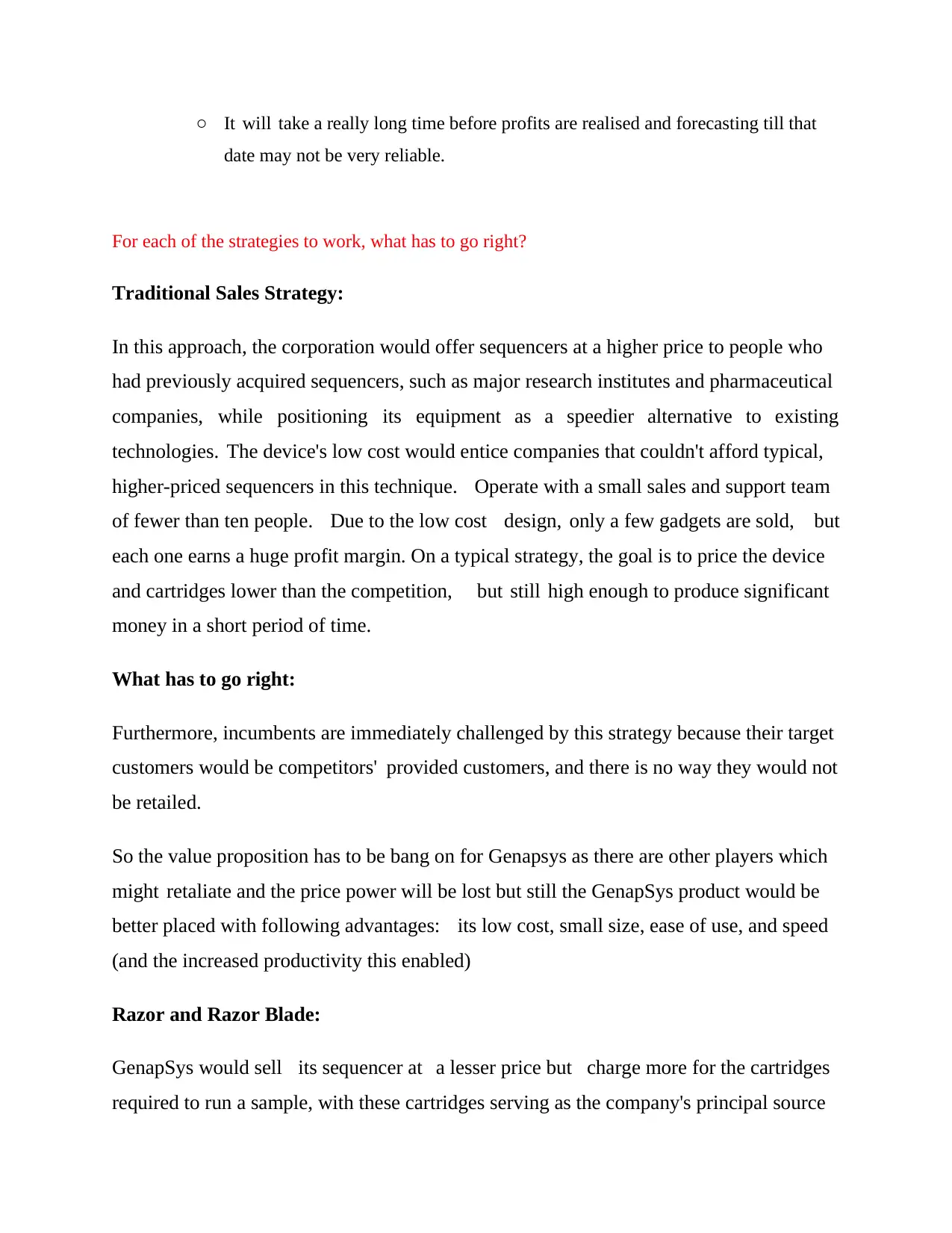
○ It will take a really long time before profits are realised and forecasting till that
date may not be very reliable.
For each of the strategies to work, what has to go right?
Traditional Sales Strategy:
In this approach, the corporation would offer sequencers at a higher price to people who
had previously acquired sequencers, such as major research institutes and pharmaceutical
companies, while positioning its equipment as a speedier alternative to existing
technologies. The device's low cost would entice companies that couldn't afford typical,
higher-priced sequencers in this technique. Operate with a small sales and support team
of fewer than ten people. Due to the low cost design, only a few gadgets are sold, but
each one earns a huge profit margin. On a typical strategy, the goal is to price the device
and cartridges lower than the competition, but still high enough to produce significant
money in a short period of time.
What has to go right:
Furthermore, incumbents are immediately challenged by this strategy because their target
customers would be competitors' provided customers, and there is no way they would not
be retailed.
So the value proposition has to be bang on for Genapsys as there are other players which
might retaliate and the price power will be lost but still the GenapSys product would be
better placed with following advantages: its low cost, small size, ease of use, and speed
(and the increased productivity this enabled)
Razor and Razor Blade:
GenapSys would sell its sequencer at a lesser price but charge more for the cartridges
required to run a sample, with these cartridges serving as the company's principal source
date may not be very reliable.
For each of the strategies to work, what has to go right?
Traditional Sales Strategy:
In this approach, the corporation would offer sequencers at a higher price to people who
had previously acquired sequencers, such as major research institutes and pharmaceutical
companies, while positioning its equipment as a speedier alternative to existing
technologies. The device's low cost would entice companies that couldn't afford typical,
higher-priced sequencers in this technique. Operate with a small sales and support team
of fewer than ten people. Due to the low cost design, only a few gadgets are sold, but
each one earns a huge profit margin. On a typical strategy, the goal is to price the device
and cartridges lower than the competition, but still high enough to produce significant
money in a short period of time.
What has to go right:
Furthermore, incumbents are immediately challenged by this strategy because their target
customers would be competitors' provided customers, and there is no way they would not
be retailed.
So the value proposition has to be bang on for Genapsys as there are other players which
might retaliate and the price power will be lost but still the GenapSys product would be
better placed with following advantages: its low cost, small size, ease of use, and speed
(and the increased productivity this enabled)
Razor and Razor Blade:
GenapSys would sell its sequencer at a lesser price but charge more for the cartridges
required to run a sample, with these cartridges serving as the company's principal source
Paraphrase This Document
Need a fresh take? Get an instant paraphrase of this document with our AI Paraphraser
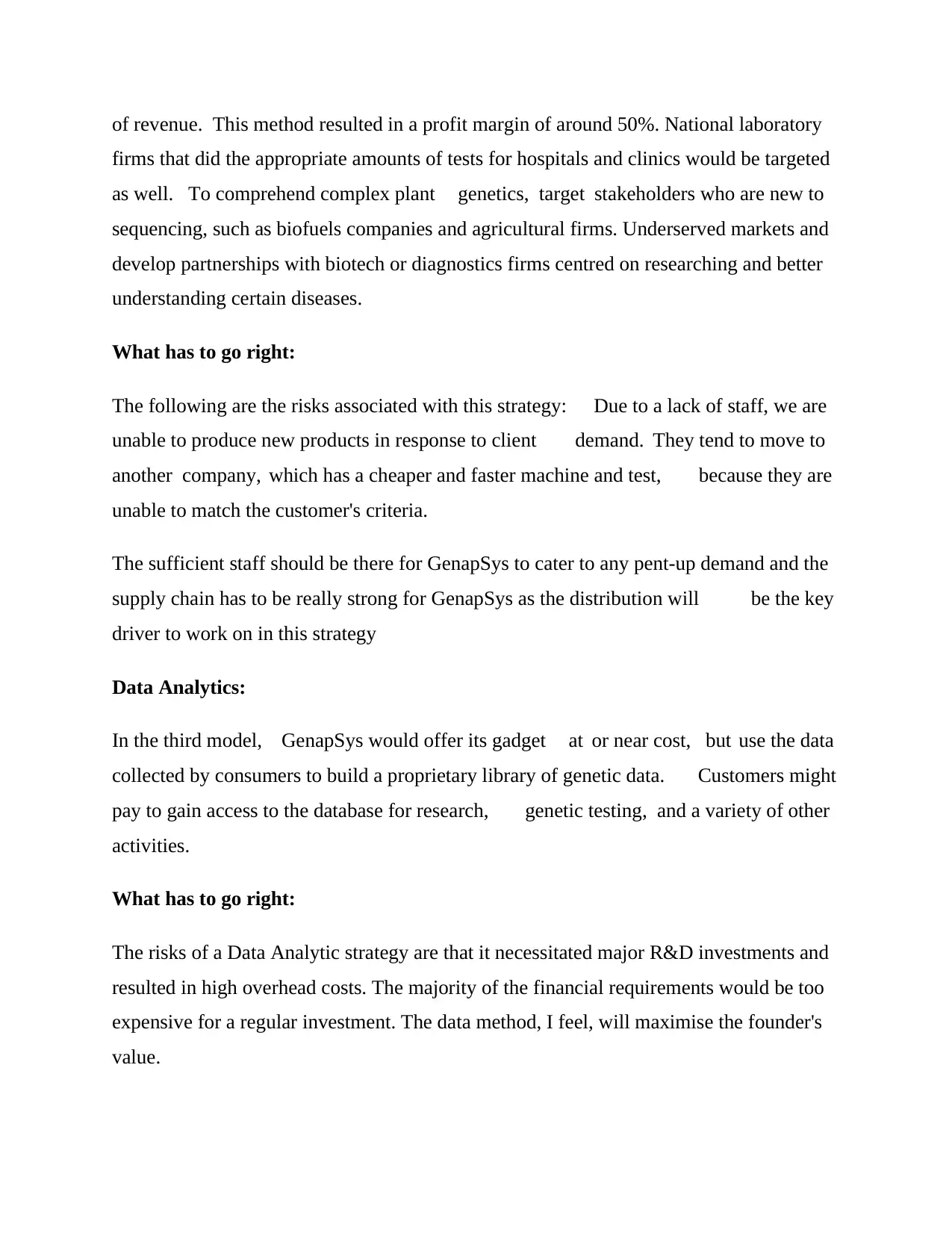
of revenue. This method resulted in a profit margin of around 50%. National laboratory
firms that did the appropriate amounts of tests for hospitals and clinics would be targeted
as well. To comprehend complex plant genetics, target stakeholders who are new to
sequencing, such as biofuels companies and agricultural firms. Underserved markets and
develop partnerships with biotech or diagnostics firms centred on researching and better
understanding certain diseases.
What has to go right:
The following are the risks associated with this strategy: Due to a lack of staff, we are
unable to produce new products in response to client demand. They tend to move to
another company, which has a cheaper and faster machine and test, because they are
unable to match the customer's criteria.
The sufficient staff should be there for GenapSys to cater to any pent-up demand and the
supply chain has to be really strong for GenapSys as the distribution will be the key
driver to work on in this strategy
Data Analytics:
In the third model, GenapSys would offer its gadget at or near cost, but use the data
collected by consumers to build a proprietary library of genetic data. Customers might
pay to gain access to the database for research, genetic testing, and a variety of other
activities.
What has to go right:
The risks of a Data Analytic strategy are that it necessitated major R&D investments and
resulted in high overhead costs. The majority of the financial requirements would be too
expensive for a regular investment. The data method, I feel, will maximise the founder's
value.
firms that did the appropriate amounts of tests for hospitals and clinics would be targeted
as well. To comprehend complex plant genetics, target stakeholders who are new to
sequencing, such as biofuels companies and agricultural firms. Underserved markets and
develop partnerships with biotech or diagnostics firms centred on researching and better
understanding certain diseases.
What has to go right:
The following are the risks associated with this strategy: Due to a lack of staff, we are
unable to produce new products in response to client demand. They tend to move to
another company, which has a cheaper and faster machine and test, because they are
unable to match the customer's criteria.
The sufficient staff should be there for GenapSys to cater to any pent-up demand and the
supply chain has to be really strong for GenapSys as the distribution will be the key
driver to work on in this strategy
Data Analytics:
In the third model, GenapSys would offer its gadget at or near cost, but use the data
collected by consumers to build a proprietary library of genetic data. Customers might
pay to gain access to the database for research, genetic testing, and a variety of other
activities.
What has to go right:
The risks of a Data Analytic strategy are that it necessitated major R&D investments and
resulted in high overhead costs. The majority of the financial requirements would be too
expensive for a regular investment. The data method, I feel, will maximise the founder's
value.
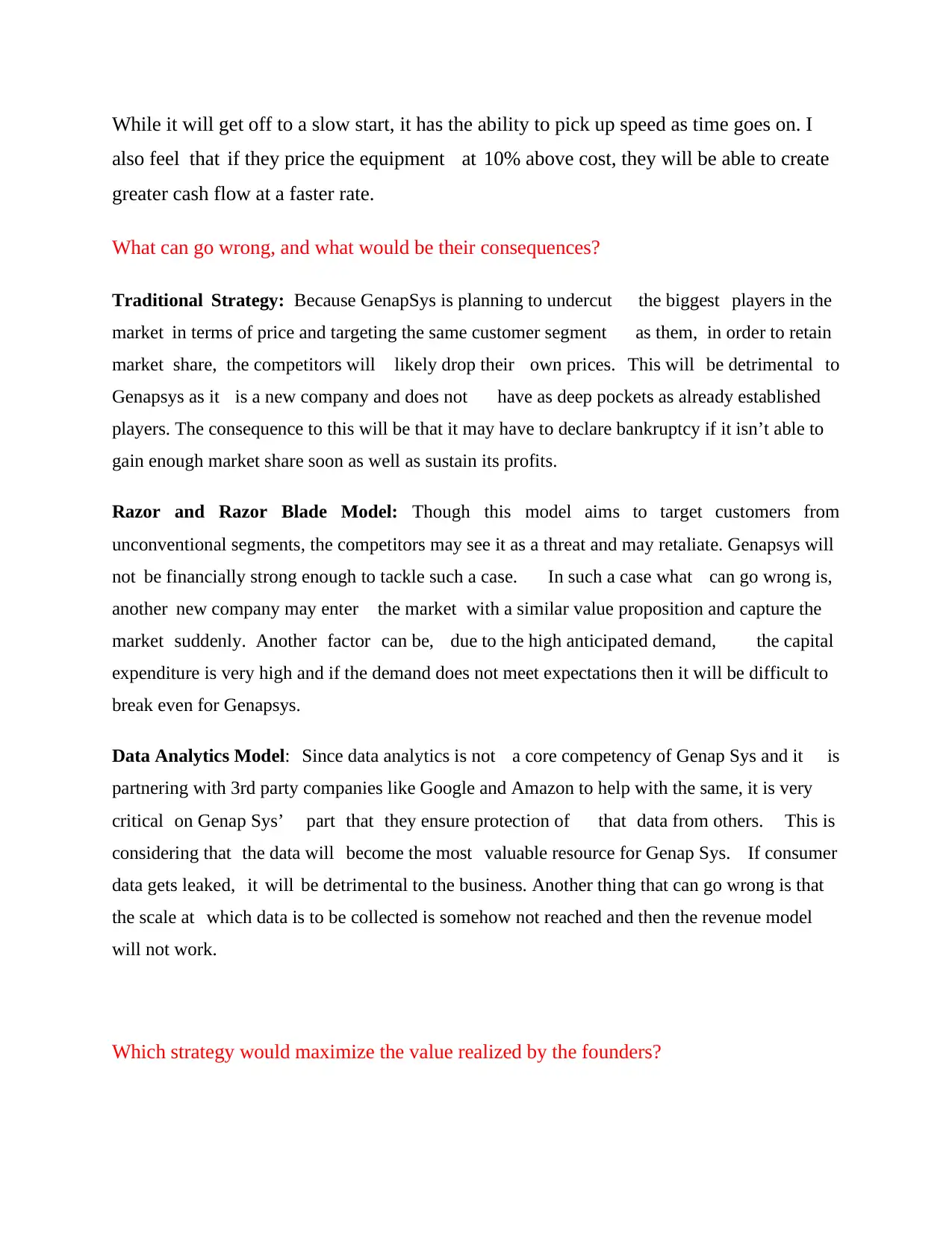
While it will get off to a slow start, it has the ability to pick up speed as time goes on. I
also feel that if they price the equipment at 10% above cost, they will be able to create
greater cash flow at a faster rate.
What can go wrong, and what would be their consequences?
Traditional Strategy: Because GenapSys is planning to undercut the biggest players in the
market in terms of price and targeting the same customer segment as them, in order to retain
market share, the competitors will likely drop their own prices. This will be detrimental to
Genapsys as it is a new company and does not have as deep pockets as already established
players. The consequence to this will be that it may have to declare bankruptcy if it isn’t able to
gain enough market share soon as well as sustain its profits.
Razor and Razor Blade Model: Though this model aims to target customers from
unconventional segments, the competitors may see it as a threat and may retaliate. Genapsys will
not be financially strong enough to tackle such a case. In such a case what can go wrong is,
another new company may enter the market with a similar value proposition and capture the
market suddenly. Another factor can be, due to the high anticipated demand, the capital
expenditure is very high and if the demand does not meet expectations then it will be difficult to
break even for Genapsys.
Data Analytics Model: Since data analytics is not a core competency of Genap Sys and it is
partnering with 3rd party companies like Google and Amazon to help with the same, it is very
critical on Genap Sys’ part that they ensure protection of that data from others. This is
considering that the data will become the most valuable resource for Genap Sys. If consumer
data gets leaked, it will be detrimental to the business. Another thing that can go wrong is that
the scale at which data is to be collected is somehow not reached and then the revenue model
will not work.
Which strategy would maximize the value realized by the founders?
also feel that if they price the equipment at 10% above cost, they will be able to create
greater cash flow at a faster rate.
What can go wrong, and what would be their consequences?
Traditional Strategy: Because GenapSys is planning to undercut the biggest players in the
market in terms of price and targeting the same customer segment as them, in order to retain
market share, the competitors will likely drop their own prices. This will be detrimental to
Genapsys as it is a new company and does not have as deep pockets as already established
players. The consequence to this will be that it may have to declare bankruptcy if it isn’t able to
gain enough market share soon as well as sustain its profits.
Razor and Razor Blade Model: Though this model aims to target customers from
unconventional segments, the competitors may see it as a threat and may retaliate. Genapsys will
not be financially strong enough to tackle such a case. In such a case what can go wrong is,
another new company may enter the market with a similar value proposition and capture the
market suddenly. Another factor can be, due to the high anticipated demand, the capital
expenditure is very high and if the demand does not meet expectations then it will be difficult to
break even for Genapsys.
Data Analytics Model: Since data analytics is not a core competency of Genap Sys and it is
partnering with 3rd party companies like Google and Amazon to help with the same, it is very
critical on Genap Sys’ part that they ensure protection of that data from others. This is
considering that the data will become the most valuable resource for Genap Sys. If consumer
data gets leaked, it will be detrimental to the business. Another thing that can go wrong is that
the scale at which data is to be collected is somehow not reached and then the revenue model
will not work.
Which strategy would maximize the value realized by the founders?
⊘ This is a preview!⊘
Do you want full access?
Subscribe today to unlock all pages.

Trusted by 1+ million students worldwide
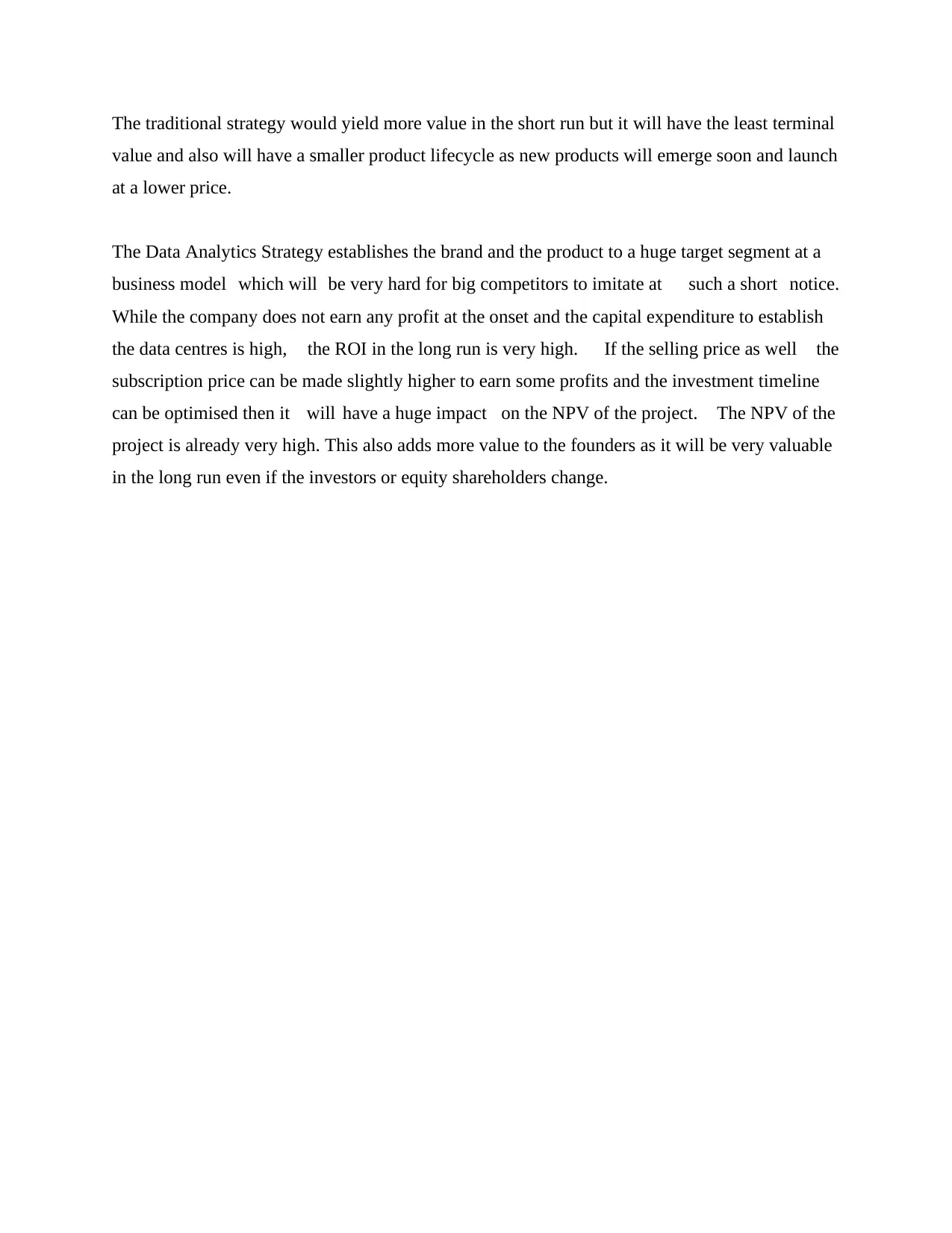
The traditional strategy would yield more value in the short run but it will have the least terminal
value and also will have a smaller product lifecycle as new products will emerge soon and launch
at a lower price.
The Data Analytics Strategy establishes the brand and the product to a huge target segment at a
business model which will be very hard for big competitors to imitate at such a short notice.
While the company does not earn any profit at the onset and the capital expenditure to establish
the data centres is high, the ROI in the long run is very high. If the selling price as well the
subscription price can be made slightly higher to earn some profits and the investment timeline
can be optimised then it will have a huge impact on the NPV of the project. The NPV of the
project is already very high. This also adds more value to the founders as it will be very valuable
in the long run even if the investors or equity shareholders change.
value and also will have a smaller product lifecycle as new products will emerge soon and launch
at a lower price.
The Data Analytics Strategy establishes the brand and the product to a huge target segment at a
business model which will be very hard for big competitors to imitate at such a short notice.
While the company does not earn any profit at the onset and the capital expenditure to establish
the data centres is high, the ROI in the long run is very high. If the selling price as well the
subscription price can be made slightly higher to earn some profits and the investment timeline
can be optimised then it will have a huge impact on the NPV of the project. The NPV of the
project is already very high. This also adds more value to the founders as it will be very valuable
in the long run even if the investors or equity shareholders change.
1 out of 7
Your All-in-One AI-Powered Toolkit for Academic Success.
+13062052269
info@desklib.com
Available 24*7 on WhatsApp / Email
![[object Object]](/_next/static/media/star-bottom.7253800d.svg)
Unlock your academic potential
Copyright © 2020–2025 A2Z Services. All Rights Reserved. Developed and managed by ZUCOL.


